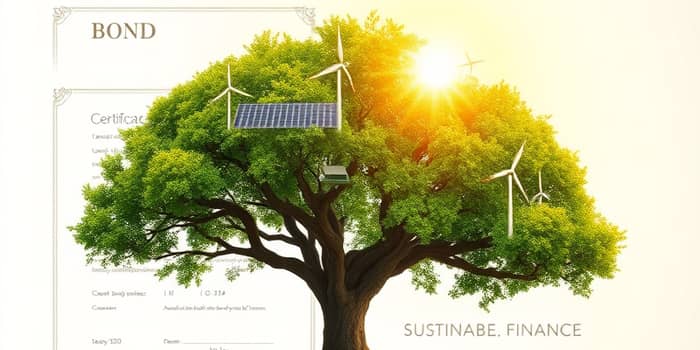In an era when climate change and resource depletion challenge the world, investors seek opportunities that combine financial returns with positive environmental impact. Among the most powerful instruments to channel capital towards sustainable solutions are green bonds. Emerging as a specialized segment of the debt market, green bonds enable institutions to raise funds exclusively for projects that mitigate environmental risk. This growing asset class not only offers competitive yields but also empowers stakeholders to align portfolios with the principles of sustainability and resilience.
Unlike traditional bonds, which finance a wide range of corporate or government initiatives, green bonds are underpinned by a commitment to environmental stewardship. Issuers commit proceeds to projects such as renewable energy generation, energy efficiency upgrades, sustainable agriculture or clean transportation. By embedding environmental objectives into the bond’s structure, green bonds foster transparency and accountability. Investors receive regular interest payments while tracking the real-world impact of their investments through standardized reporting and third-party verification.
The Evolution and Growth of Green Bonds
The concept of green bonds first took shape in 2007, but it was the World Bank’s issuance of the first labeled green bond in 2009 that truly ignited market interest. Over the past decade, issuance volumes have soared from under $1 billion to several hundred billion dollars annually. Governments, multilateral development banks, and private corporations across Europe, Asia, and the Americas have all embraced this financing tool, driven by growing regulatory support and investor demand for transparent environmental outcomes.
Market growth is fueled by a convergence of factors: heightened awareness of climate-related risks, regulatory incentives such as tax exemptions or credits, and the establishment of voluntary standards like the International Capital Market Association’s Green Bond Principles. These benchmarks set the stage for a more robust and credible market, providing guidelines on use of proceeds, project evaluation, management of funds, and ongoing disclosure.
Key Features and Standards
Green bonds share many characteristics with traditional fixed-income securities—maturity dates, coupon rates, and credit ratings—but they stand apart through their explicit use of proceeds for green projects and enhanced accountability mechanisms. Core features include:
- Use of Proceeds: Funds are dedicated entirely to environmental initiatives.
- Project Evaluation: Issuers outline selection criteria based on recognized standards.
- Management of Proceeds: Proceeds are tracked in separate accounts or portfolios.
- Reporting Requirements: Regular updates on project progress and metrics.
- Third-Party Verification: Independent review to prevent greenwashing.
Comparing Green and Traditional Bonds
Understanding the distinctions between these instruments helps investors make informed decisions. While both can offer similar risk-return profiles, green bonds introduce additional layers of transparency and impact measurement.
Eligible Projects and Impact
Green bond proceeds fund a wide range of initiatives that help address environmental challenges. Common categories include:
- Renewable Energy (solar, wind, hydroelectric)
- Energy Efficiency (building retrofits, smart grids)
- Green Buildings (LEED or BREEAM certified)
- Pollution Prevention (waste management, air quality control)
- Sustainable Agriculture and Forestry
By investing in these areas, bondholders contribute to climate change mitigation, resource conservation, and social well-being. Transparent impact metrics—such as megawatts of clean energy generated or tonnes of carbon dioxide avoided—help quantify success.
Risk and Reward: The Greenium Effect
In evaluating green bonds, investors often wonder if environmental criteria affect yield. Research indicates that green bonds can trade at a slight premium, or “greenium,” leading to marginally lower yields compared to similar non-green issues. However, this so-called greenium has narrowed over time as market liquidity and standardization improve. Moreover, potential tax incentives in jurisdictions such as France and Germany can enhance after-tax returns, further offsetting any yield differentials. Ultimately, when combined with the reputational benefits of sustainable investing, green bonds offer a compelling risk-return profile.
Practical Tips for Investors
To navigate the green bond landscape and maximize both environmental and financial returns, consider the following best practices:
- Review the Green Bond Framework: Ensure the issuer’s criteria align with recognized standards.
- Assess Reporting Commitments: Look for annual impact reports with quantitative data.
- Verify Certification: Seek bonds certified under frameworks like the Climate Bonds Standard.
- Analyze Credit Quality: Evaluate the issuer’s credit rating and overall financial health.
- Align with Portfolio Goals: Determine how green bonds enhance your portfolio diversification and meet your risk tolerance.
Overcoming Market Challenges
As the green bond market matures, investors must remain vigilant against potential pitfalls. Greenwashing—where issuers exaggerate environmental benefits—can undermine credibility. To guard against this, insist on rigorous third-party certification processes and favor issuers with a proven track record of transparency. Standardization efforts, including the EU Green Bond Standard, aim to harmonize definitions and disclosures, further strengthening market integrity.
Inspiring Change and Impact
Green bonds occupy a unique space where financial markets intersect with environmental stewardship. By directing capital towards sustainable infrastructure and technologies, investors can drive tangible progress on global challenges like climate change and biodiversity loss. This approach demonstrates that profitability and purpose can go hand in hand, creating a legacy of resilience for future generations.
Whether you are a seasoned institutional investor or an individual seeking to make a difference, green bonds offer a pathway to contribute to a more sustainable planet while pursuing competitive returns. Embrace this tool as part of a broader commitment to responsible investing and watch as collective action transforms industries, economies, and communities.
In the ever-evolving quest for sustainable growth, green bonds stand out as a beacon of innovation and responsibility. By choosing to support projects that protect ecosystems, reduce emissions, and promote social equity, you become part of a global movement. Let your capital reflect your values—support the green bond market and help pave the way for a healthier, more prosperous world.
References
- https://www.icmagroup.org/sustainable-finance/the-principles-guidelines-and-handbooks/green-bond-principles-gbp/
- https://www.investopedia.com/terms/g/green-bond.asp
- https://betterbuildingssolutioncenter.energy.gov/financing-navigator/option/green-bonds
- https://earth.org/explainer-what-are-green-bonds/
- https://www.weforum.org/stories/2024/11/what-are-green-bonds-climate-change/
- https://blogs.cfainstitute.org/investor/2019/10/08/green-bonds-vs-traditional-bonds/
- https://vasscompany.com/us-can/en/insights/blogs-articles/green-bonds/










